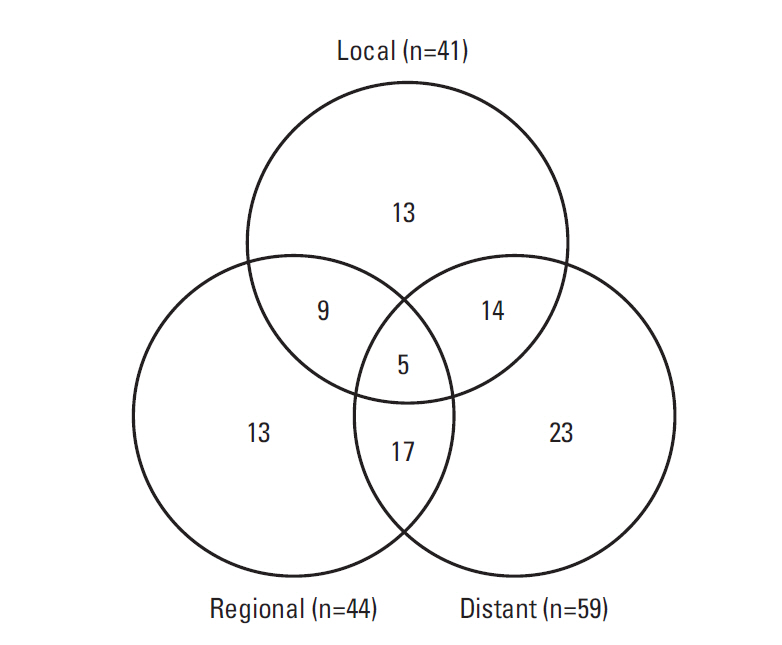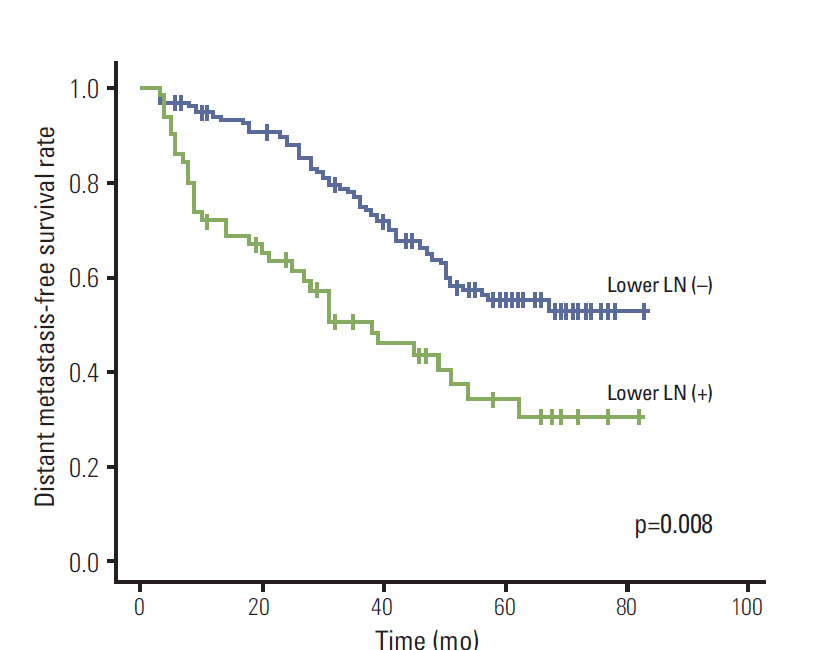Cancer Res Treat.
2015 Jan;47(1):46-54. 10.4143/crt.2013.212.
Analysis of the Prognostic Factors for Distant Metastasis after Induction Chemotherapy Followed by Concurrent Chemoradiotherapy for Head and Neck Cancer
- Affiliations
-
- 1Department of Radiation Oncology, Biomedical Research Institute, Pusan National University Hospital, Pusan National University School of Medicine, Busan, Korea. rokwt@hanmail.net
- 2Department of Radiation Oncology, Pusan National University Yangsan Hospital, Pusan National University School of Medicine, Yangsan, Korea.
- 3Department of Otorhinolaryngology, Biomedical Research Institute, Pusan National University Hospital, Pusan National University School of Medicine, Busan, Korea.
- 4Department of Hemato-oncology, Biomedical Research Institute, Pusan National University Hospital, Pusan National University School of Medicine, Busan, Korea.
- KMID: 2380389
- DOI: http://doi.org/10.4143/crt.2013.212
Abstract
- PURPOSE
The aim of this study is to identify the prognostic factors of distant metastasis (DM) after induction chemotherapy (IC) followed by concurrent chemoradiotherapy (CRT) for locoregionally advanced head and neck cancer (HNC).
MATERIALS AND METHODS
A total of 321 patients with HNC who underwent IC followed by CRT treated between January 2005 and December 2010 were analyzed retrospectively. IC consisted of three courses of docetaxel (70 mg/m2) and cisplatin (75 mg/m2) every three weeks, followed by radiotherapy of 66-70 Gy/2 Gy per fraction/5 fractions per week concurrent with weekly cisplatin (40 mg/m2). Tumor/nodal stage, primary site, tumor differentiation, lower neck node involvement (level IV, VB, and supraclavicular regions), number of concurrent chemotherapy cycles, overall duration of radiotherapy, and response to IC were assessed as potential prognostic factors influencing DM and survival outcome.
RESULTS
The five-year loco-regional recurrence and DM rates were 23.6% and 18.2%. N stage, overall duration of radiotherapy, lower neck node involvement, and response to IC were significant factors for DM. With a median follow-up period of 52 months (range, 4 to 83 months), the 5-year progression-free, DM-free, and overall survival rates were 41.2%, 50.7%, and 55.1%, respectively. Lower neck node involvement (p=0.008) and poor response to IC (p < 0.001) showed an association with significantly inferior DM-free survival.
CONCLUSION
Even with the addition of IC, the DM rate and survival outcome were poor when metastatic lower neck lymph nodes were present or when patients failed to respond after receiving IC.
Keyword
MeSH Terms
Figure
Cited by 1 articles
-
Predictors of Distant Metastasis after Radical Surgery Followed by Postoperative Radiotherapy with or without Chemotherapy for Oropharyngeal Cancer
Mi Joo Chung, Yeon Sil Kim, Ji Yoon Kim, Yun Hee Lee, Ji Hyun Jang, Jin Hyoung Kang, Ie Ryung Yoo, Youn Soo Lee
Cancer Res Treat. 2016;48(4):1167-1176. doi: 10.4143/crt.2015.379.
Reference
-
References
1. Lee JH, Song JH, Lee SN, Kang JH, Kim MS, Sun DI, et al. Adjuvant postoperative radiotherapy with or without chemotherapy for locally advanced squamous cell carcinoma of the head and neck: the importance of patient selection for the postoperative chemoradiotherapy. Cancer Res Treat. 2013; 45:31–9.
Article2. Adelstein DJ, Li Y, Adams GL, Wagner H Jr, Kish JA, Ensley JF, et al. An intergroup phase III comparison of standard radiation therapy and two schedules of concurrent chemoradiotherapy in patients with unresectable squamous cell head and neckcancer. J Clin Oncol. 2003; 21:92–8.3. Haddad RI, Shin DM. Recent advances in head and neck cancer. N Engl J Med. 2008; 359:1143–54.
Article4. Leemans CR, Tiwari R, Nauta JJ, van der Waal I, Snow GB. Regional lymph node involvement and its significance in the development of distant metastases in head and neck carcinoma. Cancer. 1993; 71:452–6.
Article5. Leon X, Quer M, Orus C, del Prado Venegas M, Lopez M. Distant metastases in head and neck cancer patients who achieved loco-regional control. Head Neck. 2000; 22:680–6.
Article6. Cohen EE, Karrisson T, Kocherginsky M, Huang CH, Agulnik M, Mittal BB, et al. DeCIDE: a phase III randomized trial of docetaxel (D), cisplatin (P), 5-fluorouracil (F) (TPF) induction chemotherapy (IC) in patients with N2/N3 locally advanced squamous cell carcinoma of the head and neck (SCCHN). J Clin Oncol. 2012; 30(S):Abstr 5500.
Article7. Garavello W, Ciardo A, Spreafico R, Gaini RM. Risk factors for distant metastases in head and neck squamous cell carcinoma. Arch Otolaryngol Head Neck Surg. 2006; 132:762–6.
Article8. Ellis ER, Mendenhall WM, Rao PV, Parsons JT, Spangler AE, Million RR. Does node location affect the incidence of distant metastases in head and neck squamous cell carcinoma? Int J Radiat Oncol Biol Phys. 1989; 17:293–7.
Article9. Sher DJ, Posner MR, Tishler RB, Sarlis NJ, Haddad RI, Holupka EJ, et al. Relationship between radiation treatment time and overall survival after induction chemotherapy for locally advanced head-and-neck carcinoma: a subset analysis of TAX 324. Int J Radiat Oncol Biol Phys. 2011; 81:e813–8.
Article10. Bhide SA, Ahmed M, Barbachano Y, Newbold K, Harrington KJ, Nutting CM. Sequential induction chemotherapy followed by radical chemo-radiation in the treatment of locoregionally advanced head-and-neck cancer. Br J Cancer. 2008; 99:57–62.
Article11. van den Brekel MW, Stel HV, Castelijns JA, Nauta JJ, van der Waal I, Valk J, et al. Cervical lymph node metastasis: assessment of radiologic criteria. Radiology. 1990; 177:379–84.
Article12. Edge SB, Byrd DR, Compton CC, Fritz AG, Greene FL, Trotti A. AJCC cancer staging manual. 7th ed. New York: Springer;2009.13. Miller AB, Hoogstraten B, Staquet M, Winkler A. Reporting results of cancer treatment. Cancer. 1981; 47:207–14.
Article14. Vokes EE, Kies MS, Haraf DJ, Stenson K, List M, Humerickhouse R, et al. Concomitant chemoradiotherapy as primary therapy for locoregionally advanced head and neck cancer. J Clin Oncol. 2000; 18:1652–61.
Article15. Machtay M, Rosenthal DI, Hershock D, Jones H, Williamson S, Greenberg MJ, et al. Organ preservation therapy using induction plus concurrent chemoradiation for advanced resectable oropharyngeal carcinoma: a University of Pennsylvania Phase II Trial. J Clin Oncol. 2002; 20:3964–71.
Article16. Shin HJ, Chung JS, Choi YJ, Lee BJ, Wang SG, Kim DW, et al. Neoadjuvant docetaxel and cisplatin chemotherapy followed by local irradiation is highly active on locoregionally advanced squamous cell carcinoma of the head and neck. J Laryngol Otol. 2008; 122:722–7.
Article17. Posner MR, Hershock DM, Blajman CR, Mickiewicz E, Winquist E, Gorbounova V, et al. Cisplatin and fluorouracil alone or with docetaxel in head and neck cancer. N Engl J Med. 2007; 357:1705–15.
Article18. Alvi A, Johnson JT. Development of distant metastasis after treatment of advanced-stage head and neck cancer. Head Neck. 1997; 19:500–5.
Article19. Spector JG, Sessions DG, Haughey BH, Chao KS, Simpson J, El Mofty S, et al. Delayed regional metastases, distant metastases, and second primary malignancies in squamous cell carcinomas of the larynx and hypopharynx. Laryngoscope. 2001; 111:1079–87.
Article20. Johnson JT, Wagner RL, Myers EN. A long-term assessment of adjuvant chemotherapy on outcome of patients with extracapsular spread of cervical metastases from squamous carcinoma of the head and neck. Cancer. 1996; 77:181–5.
Article21. Garden AS, Asper JA, Morrison WH, Schechter NR, Glisson BS, Kies MS, et al. Is concurrent chemoradiation the treatment of choice for all patients with Stage III or IV head and neck carcinoma? Cancer. 2004; 100:1171–8.
Article22. Kalnins IK, Leonard AG, Sako K, Razack MS, Shedd DP. Correlation between prognosis and degree of lymph node involvement in carcinoma of the oral cavity. Am J Surg. 1977; 134:450–4.
Article23. Vermorken JB, Remenar E, van Herpen C, Gorlia T, Mesia R, Degardin M, et al. Cisplatin, fluorouracil, and docetaxel in unresectable head and neck cancer. N Engl J Med. 2007; 357:1695–704.
Article
- Full Text Links
- Actions
-
Cited
- CITED
-
- Close
- Share
- Similar articles
-
- Organ Preservation for the Management of Locally Advanced Head and Neck Cancer
- Solitary Splenic Metastasis from Head and Neck Cancer: A Case Report
- Less is more: role of additional chemotherapy to concurrent chemoradiotherapy in locoregionally advanced nasopharyngeal cancer management
- Locoregionally advanced nasopharyngeal carcinoma treated with intensity-modulated radiotherapy plus concurrent weekly cisplatin with or without neoadjuvant chemotherapy
- A Case of Esophageal Cancer Showing Intramural Metastasis to the Stomach in Complete Remission with Preoperative Chemoradiotherapy




